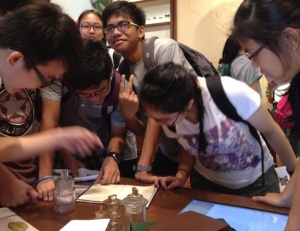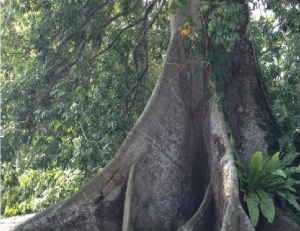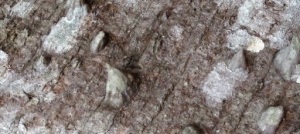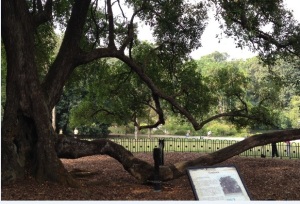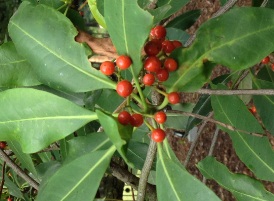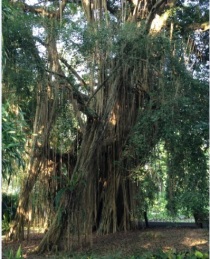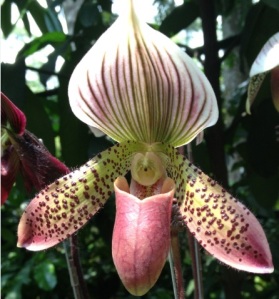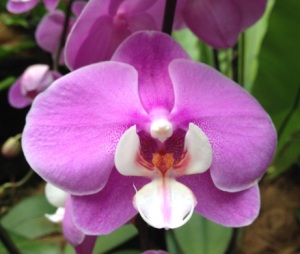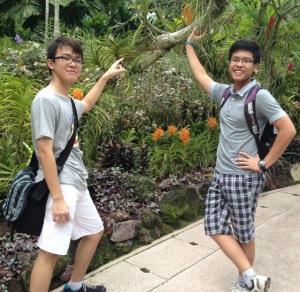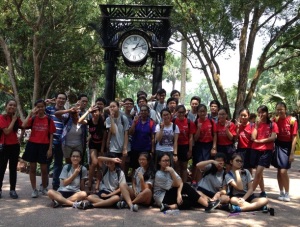Sexual reproduction of plants
For a quick revision on this topic, click here.
Please take the quiz on the AsknLearn portal (accounts for students will be given in January 2015).
Introduction
Insect Pollinators
Insect pollinators play a very important role in the sexual reproductive cycle of plants. Seen below is Oriental Honeybee visiting flowers of Red Powderpuff / Calliandra haematocephala in Singapore Botanical Gardens.
They help to carry pollen grains from the male organs to the female organs of flowers. This ensures successful fertilisation of male and female gametes that result in production of seeds.
Studies have shown that a lack of insect pollinators can lead to the loss of flowering plant species. This is particularly significant in Singapore, where the majority of native flowering plant species are currently endangered or vulnerable.
1. Bees
Bees are the most important pollinators of the insect world. This is due to the fact that they need to gather large quantities of nectar and pollen to feed themselves and their larvae.
Two commonly spotted bee pollinators in Singapore are the Oriental Honeybee and Carpenter Bee (photographed at Kay Siang Rd, outside old MOE building and Hort Park).
- Top – an Oriental Honeybee / Apis cerana visiting flowers of Thailand Powderpuff / Combretum constrictum
- Bottom – a Carpenter Bee / Xylocopa Latipes visiting flowers of Sendudok or Melanstoma malabathricum
Read about other bees spotted in parks in Singapore in the Apr-Jun 2014 issue of My Green Space by NParks. You can also learn more about the role of wild bees in plant pollination in a report here.
2. Butterflies
There are many butterflies species that roam our parks and gardens that assist in the pollination of plants. Featured here are the Pale Grass Blue Butterfly and the Common Rose Butterfly (photographed at Alexandra Canal Park/Singapore Botanical Gardens):
- Top – a Pale Grass Blue Butterfly / Zizeeria maha serica visiting the weed Cupid’s Shaving Brush / Emilia sonchifolia
- Bottom – a Common Rose Butterfly / Pachliopta aristolochiae asteris visiting the ornamental plant Pseuderanthemum laxiflorum.
Read the next blogs on Pollination of Plants, Wind Pollinated Plants and Insect Pollinated Plants.
Pollination of Plants
Pollination is defined as the transfer of pollen grains from the anther (containing the pollen grains) to the stigma.
There are 2 methods of pollination – insect pollination and wind pollination. Read more in the blogs on insect pollinated flowers and wind pollinated flowers.
Shown below is an example of pollination in the Crinium lily plant. Notice the orange pollen grains sticking onto the stigma and style of the flower. 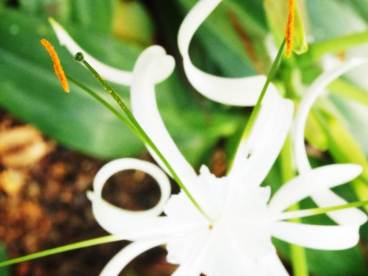
There are two types of pollination – self pollination and cross pollination.
Self-pollination is the transfer of pollen grains from the anther and stigma of the same flower or of a different flower on the same plant. Cross pollination is the transfer of pollen grains from one plant to the stigma of a flower in another plant of the same species.
Studies have shown that only 10–15% of flowering plants are self-fertilizing. For example, orchid flowers are bisexual and are able to be self-pollinated/fertilised. The photograph below taken at the Singapore Botanical Gardens shows a typical Orchid (Aranda Prapin yellow) with two white pollen sacs at the top and the stigma next to it in the same tube. The pollen grains can be self-pollinated by wind, insect or even by hand!
After successfully landing on the stigma by insect or wind pollination, the pollen grain will germinate, carrying the male gamete down the style to reach the ovary, which contains the ovum or female gamete.
Shown below is the long style of the Spider lily (same family as Crinium lily) flower, which the pollen grain must germinate in order to reach the ovary.
Fertilisation takes place when the male gamete fuses with the female gamete, and the seed is formed. The ovary turns into the fruit.
The photographs below shows the fruit formed for the Peacock Flower / Caesalpina pulcherrima (after successful pollination and fertilisation).
The female Lemon Immigrant Butterfly / Catopsilia pomona pomona visits the Peacock Flowers and probably aids in its pollination.
Wind Pollinated Flowers
Wind pollinated flowers rely on wind to carry the pollen from the anther of a flower to the stigma of another flower.
Wind pollinated flowers possess the following characteristics :
- They are small and dull-coloured, often without petals.
- Nectar and nectar guides are absent
- Stigmas are large, feathery and usually protrude out of the flower. The feathery stigma increases the surface area to capture pollen in the air.
- Stamens are generally long and pendulous, and the anthers protrude out of the flower to allow pollen grains to be carried by the wind.
- Anther produces large quantities of pollen grains as there is considerable number that will not be able to reach the stigma of other flowers.
Most grasses and economically important crops such as rice, wheat and corn, and some tree species rely on wind for pollination.
1. Seashore Centipede Grass / Ischaemum muticum
Like many other grass species, Ischaemum muticum is wind pollinated. It is widespread in Singapore and thrives well in water pools and in seasonally flooded and marshy places. As its flowers are wind-pollinated, it does not need colourful and attractive petals to attract insect pollinators. They only have green bracts (modified leaves) enveloping the reproductive organs. The stigmas are feathery and yellow stamens are long and pendulous. See photos taken along Alexandra Canal Park:
- Top – Feathery stigmas can clearly seen.
- Middle – Yellow pendulous stamens stick out of the green bracts.
- Bottom – A grass shoot.
2. Narrow Leaf Cattail / Typha angustifolia
The Cattail plant is easily recognised by its brown sausage-like inflorescences (stalks bearing multiple flowers). It is wind pollinated. The male flowers are located at the top of the stalk while the female flowers are located from the middle to bottom section.
This plant is also used for phyto-remediation purposes in Singapore and hence planted widely near to canals and water bodies.
The cattail reproduce by seed and asexually by vegetative means through rhizomes (swollen roots). Each spike is said to contain as much as 117,000 to 268,000 tiny seeds. At maturity, the seeds are dispersed by wind. Each seed has hairs to increase the surface area to enable it to travel greater distances.
Insect Pollinated Flowers
Insect pollinated flowers rely on agents such as insects (e.g. bees, butterflies), birds (e.g. sunbird, hummingbird) and animals (e.g. bats) to pollinate their flowers, i.e. carry pollen from the anther to reach the stigma.
Insect pollinated flowers possess the following characteristics:
- Large flowers with brightly colored petals to attract insects.
- Flowers are usually sweet smelling or fragrant with nectar present.
- Stigmas are usually small, compact and do not protrude out of the flower.
- Stamens are not pendulous and are located within the interiors of the flower, so that pollen can stick on the backs of pollinators as they brush against the anthers.
- Nectar guides present to guide the pollinators towards the nectar.
Different species of flowers may be pollinated by the same insect. In fact, the Oriental Honeybee has been observed to pollinate as many as 29 species of flowers! (source : 2013 article on bees and wasps as insect pollinators). The pictures shows Oriental Honey bees visiting flowers of 3 species of plants:
- Top – Rose-flowered Jatropha / Jatropha integerrima (taken in Alexandra Canal Park)
- Middle – Creeping Daisy /Sphagneticola trilobata (taken in Hort Park)
- Bottom – Thailand Powderpuff / Combretum constrictum (taken just outside Kay Siang Road, the old MOE building)
1. Orchids The Orchid family, Orchidaceae is the largest family of flowering plants in the world. It is estimated that 10% of all flowering species are orchids! Orchid plants rely on insect pollinators such as bees, and hence have:
- large, attractive and fragrant petals and sepals (3 sepals and 3 petals).
- highly modified third lower petal, called the labellum/lip is usually highly modified to attract insects.
- nectar guides to guide the insect to the 2 pollen sacs (called pollinia in orchids).
Shown below is a VIP orchid, Dendrobium Hifikipunye Pohamba bred in National Orchid Garden, Singapore Botanical Gardens. Note the pair of white pollen sacs and the nectar guides in the labellum.
Shown next is a native Singapore orchid, Arundina graminifolia or Bamboo Orchid (photographed on the grounds of Gardens by the Bay). Observe its nectar guides present on the beautiful and elaborate labellum.
2. Blue Butterfly Pea / Clitoria ternatea The native tropical plant, Clitoria ternatea or Blue Butterfly Pea is insect-pollinated. Its flowers are bisexual, solitary or in pairs and blue or white (source : Raffles Museum of Biodiversity Research, NUS). The flowers produce a blue dye commonly used in coloring glutinous rice cakes. A group of NTU scientists discovered a new molecule in this plant which can join together chains of amino acids. This enzyme molecule is named Butelase-1 after the plant’s Malay name Bunga Telang. Read the article published on Oct 2014. Here are its flowers photographed at Alexandra Canal Linear Park. The plant is a climber. 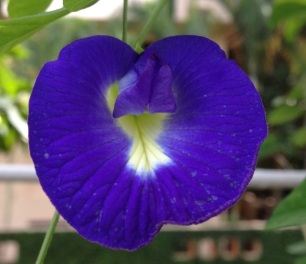
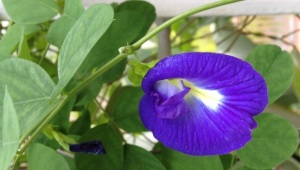 The blue petals are initially enclosed by green sepals in the bud stage as shown below.
The blue petals are initially enclosed by green sepals in the bud stage as shown below. 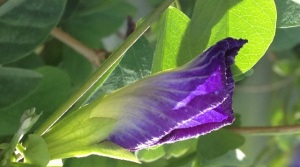
A dissected flower reveals a total of 5 petals comprising the corolla of each flower:
- 1 Standard petal
- 2 Wing petals
- 2 Keel petals
The wing and keel petals enclose the male (androecium) and female (gynoecium) organs while the large standard petal attracts and provides a landing pad for pollinators. As it is a bisexual flower, it has male and female organs both in each mature flower. The sexual reproductive organs are enclosed by the two smaller yellowish keel petals and which in turn are covered by two slightly larger purple-tipped wing petals. 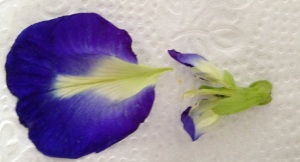
The green parts are the sepals (calyx). The yellow anthers with filaments, and surrounded by the stigma and style, can be seen (pointing at three o’clock).
3. Spanish Shawl / Dissotis rotundifolia and Sendudok / Melanstoma malabathricum Both plant species belong to the same family (Melastomataceae) and have insect-pollinated bisexual flowers consisting of:
- 5 pink petals (Spanish Shawl are deeper pink compared to Sendudok)
- 10 stamens – 5 stamens are larger with curved purple ends and 5 stamens are shorter with straight yellow ends. Notice the two lobes at the end of each short stamen.
- 1 carpel (curved in the centre)
The flower shown below is that of Spanish Shawl. Note the distinctive characteristic of 3 prominent veins in each leaf. The leaves of Spanish Shawl is rounder than Sendudok.
The buds of the Spanish Shawl look like that below:
The Sendudok or Melanstoma malabathricum (mistakenly called Singapore Rhodendron) flowers and shrubs are commonly seen along the roadside and parks. The flowers are insect-pollinated by bees, such as carpenter bees. The photographs below taken at Hort Park show the plant and its fruits (top) and the carpenter bee visiting it (bottom).
The fruits are highly sought after by birds! Find out more in this webpage maintained by the Bird Ecology Study Group.
4. Rose-Flowered Jatropha / Jatropha Integerrima The Rose-Flowered Jatropha, also known as Spicy Jatropha or Peregrina is a shrub that is planted widely in parks in Singapore due to its attractive flowers with red petals and anthers (its anther lobes are lined with yellow pollen grains). It is observed to be pollinated by Oriental Honeybees in Alexandra Canal Park.
It has unisexual flowers, i.e. separate female (top) and male (middle) flowers on the same plant (bottom). The gynoecium of each female flower consists of 3 carpels. The androecium of each male flower consists of 10 stamens.
5. Spider Lily / Hymenocallis speciosa
The spider lily is a common ornamental plant that is seen in many parks and gardens, including Fu Shan garden. It is insect-pollinated. The species has white flowers (with a tinge of green). Click here to learn more about other spider lilies around the world.
Each flower consists of 6 narrow, curved tepals (comprising of 3 petals and 3 sepals) attached to a shallow cup that is formed from the fused stamens. The first name Hymenocallis is derived from the Greek words ὑμήν (hymen), meaning “membrane”, and καλός (kalos), meaning “beautiful”. The flower is bisexual with 6 stamens and 1 central carpel. The 6 stamens give the flower the appearance of the legs of a spider!
The style of each flower is actually very long and runs along a green tube that protects it. The style is connected to the ovary at the base.
6. Blue Trumpet Vine / Thunbergia laurifolia
The Blue Trumpet Vine (it belongs to a family of plants commonly known as “Morning Glory”) is a climber that grows well and flowers easily in Singapore’s climate. It is observed to be visited/probably pollinated by Carpenter bees. The photograph below is taken in a private estate near Alexandra Canal Park. The bee squeezes in and hence would brush against the stamens and pick up the pollen grains.
It is a bisexual flower with 1 central carpel (Top Photo) and 4 stamens (Bottom Photo).
7. Cupid’s Shaving Brush / Emilia sonchifolia
This native weed is found through Singapore and is present almost everywhere, wherever there is a small patch of grass you will find this plant! It is member of the sunflower family and hence the flowers are usually clustered together in an inflorescence.
Each flower consists of 5 stamens and 1 carpel. It is insect-pollinated and Pale Grass Blue Butterfly has been observed feeding on it and probably aids it in pollination. The photograph was taken in Admiralty Park.
After successful pollination/fertilisation, the white powerpuff-looking fruits will be wind-dispersed. See photograph below taken at Alexandra Canal Park.
8. Cannonball Tree
The Cannonball tree is insect pollinated with highly-modified male reproductive structures (androecium) which comprises of pink and yellow tipped stamens and “cannonball-like” fruits.
The flowers are strongly scented to attract pollinators such as bees. Each tree can bear 1000 flowers and 150 fruits at each time! It is native to the rain forests of Central and South America. You can spot a Cannonball tree at next to Blk 823 in Fu Shan Garden, just across the road from the main gate of Riverside Secondary School.
9. Crepe Ginger / Costus Speciosus
The Crepe Ginger is an insect-pollinated plant species that is native to the Malay Peninsula of Southeast Asia. Its common name of Crepe Ginger is derived from the crepe-like flower petals.
It has red ginger-like leaves arranged around the stem and beautiful white flowers on the heads. It has been observed to be pollinated by bees. The flowers shown was photographed in Hort Park.
10. Alligator Flag / Thalia geniculata This plant is an animal-pollinated ornamental plant (native to North America) that is used for phytoremediation purposes in canals and ponds in Singapore, such as Alexandra Canal and the pond (next to Sakura restaurant) in Admiralty Park.
Phytoremediation refers to the process whereby plants are able to absorb toxins through its roots and thus help to remove poisonous chemicals such as fertiliser wastes, insecticides and heavy metals from water.
The 2 long white dangling “petals” actually bracts (modified leaves). The purple flowers have 3 petals each. It is pollinated by birds.
Visit to Singapore Botanical Gardens
As part of their learning in the topics of Plant Reproduction and Ecosystem diversity, the Pure Biology students were given the opportunity to visit the Singapore Botanical Gardens and National Orchid Garden for a learning journey on 30 Oct 2014. The aim of the trip is to help them to relate their concepts that they learnt to the tremendous diversity of plants as well as understanding the role of conservation of native species and other species of historical tree species, which are called Heritage Trees.
Students visited the new Singapore Botanical Gardens (SBG) Heritage Museum, which shows exhibits related to the historical background of the SBG and how it is intertwined with the scientific, cultural and economic development of Singapore.
The students observed their first heritage tree just outside the SBG Heritage museum, which is the Silk Cotton Tree, or Kapok. The white springy fibers present in its seed pods are used to stuff life jackets, cushions and mattresses. The tree has two interesting characteristics, large buttress roots and thorns on its bark.
The second heritage tree that the students observed was the Tembusu tree (called “$5 tree” as it appears on the back of the $5 Singapore note). There were plenty of red fruit berries produced from the flowering season between the months of April to July. This Heritage Tree is reportedly more than 150 years old.
Students were intrigued by the “Strangling Fig” Heritage Tree, Burmese Banyan. This tree begins its life as seeds deposited in the branches on another tree and subsequently sends its aerial roots down to the forest floor, eventually “strangling” its host tree. To learn more about Fig trees in Singapore, click on the link “Native Fig Species as a Keystone Resource for the Singapore Urban Environment” published by the Raffles Museum of Biodiversity Research, NUS.
After spending an hour observing heritage trees, students spent the next half of the learning journey at the National Orchid Garden. It was a pleasant surprise that we were able to see the “King of Orchids”, Paphiopedilum rothschildianum at the Tan Hoon Siang Mist House in the National Orchid Garden. This orchid is an endangered orchid species endemic to Mount Kinabalu, Sabah, and Malaysia. Its unique features are its green and red spotted petals which are almost horizontal and beautiful pouch-like pink labellum.
There was truly a wide array of orchid hybrids and varieties that can be enjoyed, such as the Phalaenopsis orchids. The two pollinia (pollen sacs) characteristic of all orchid flowers can be prominently seen, as well as the arrowhead-shaped viscidium (sticky pad). The lip (petal) is beautifully modified to serve as a landing platform for pollinators.
Besides relating the reproductive structures of the orchid to their learning in the chapter of Plant Reproduction, the students also picked up interesting points about the growth and habitats of orchids, such as the difference between terrestrial (growing in the ground) and epiphytic orchids (growing on trees). In the picture below, one can observe epiphytic orchid growing on the tree and terrestrial orchids in the ground. This is similar to ferns which can often grow from trees, e.g. bird nest fern, stag horn ferns or grow in the ground.
Of course, no trip is complete without a group photo. Here’s one taken just outside the National Orchid Garden.

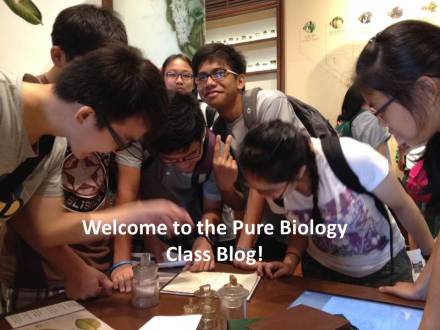
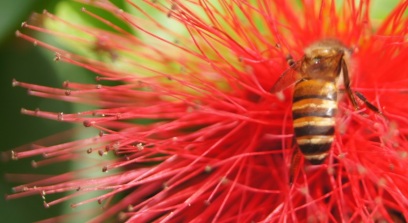
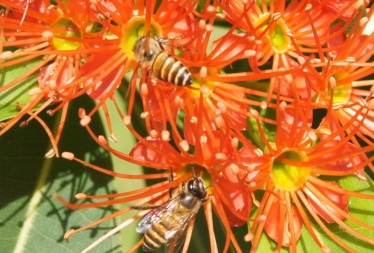
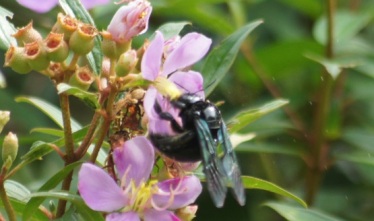
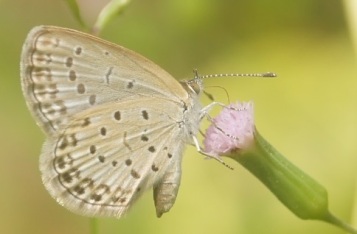
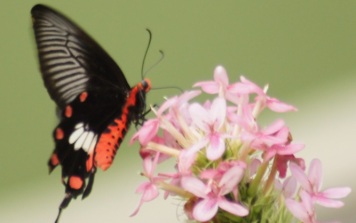
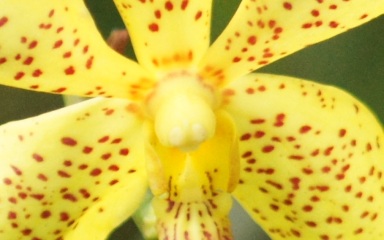
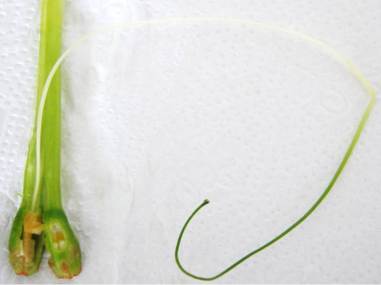
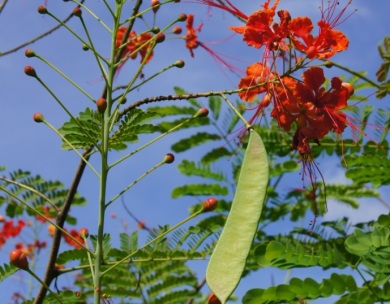
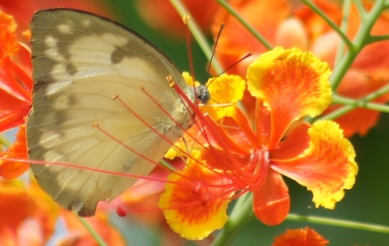
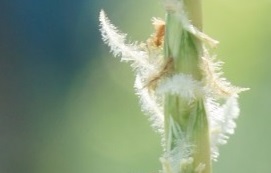
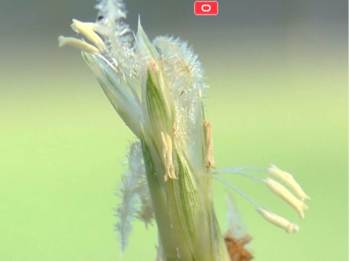
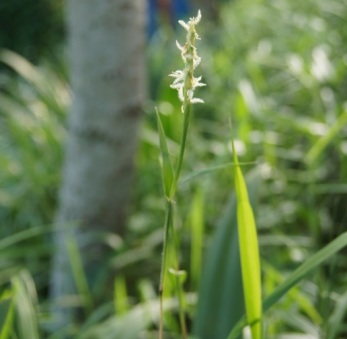
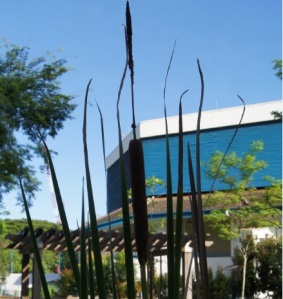
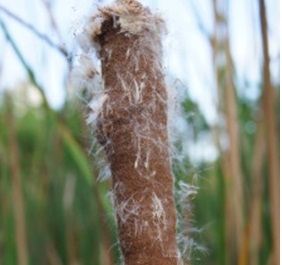
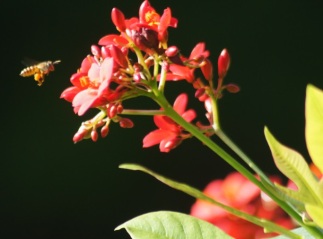
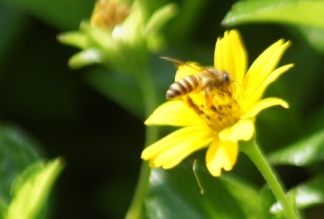
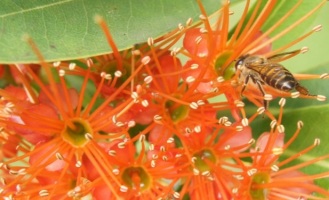
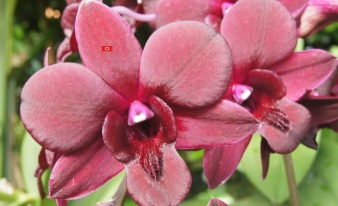
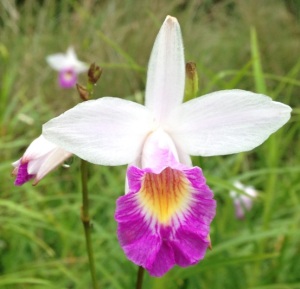
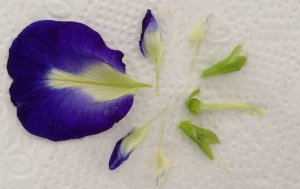
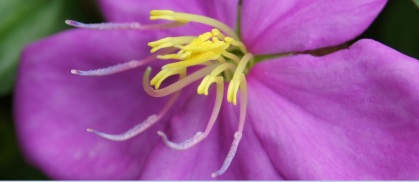
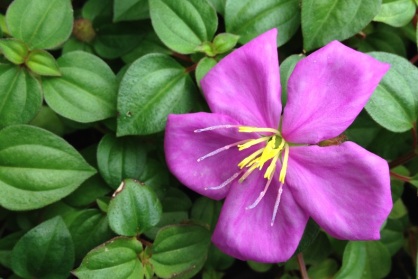
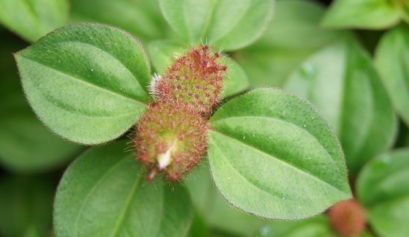
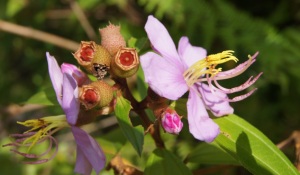
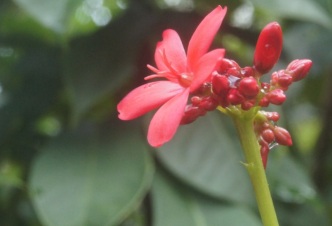
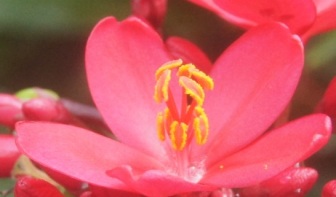
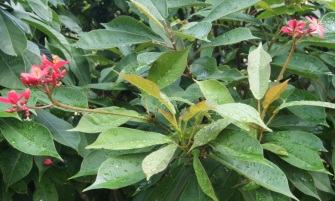
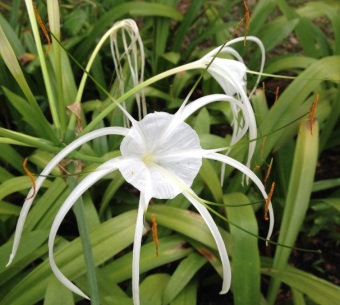
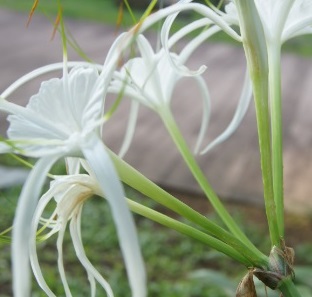
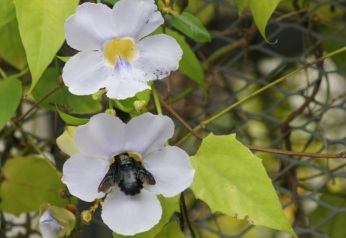
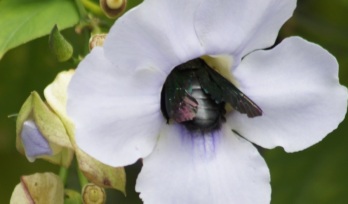
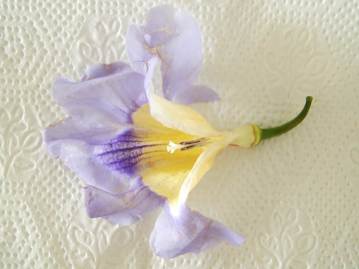
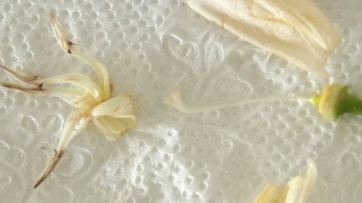
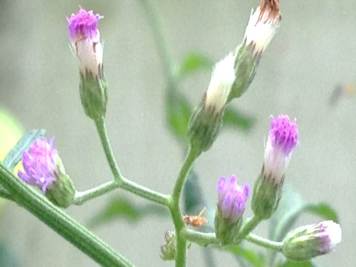
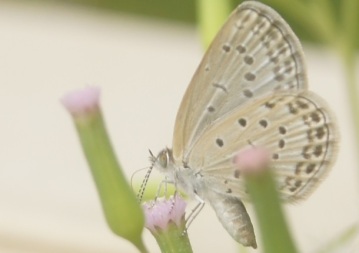
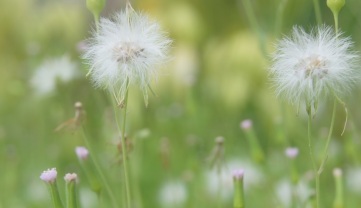
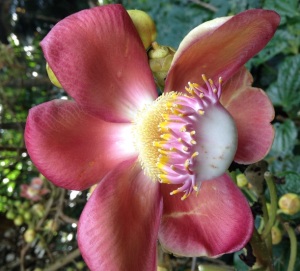
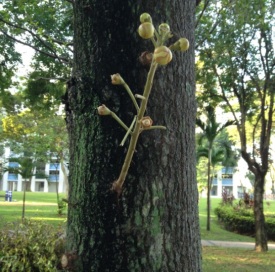
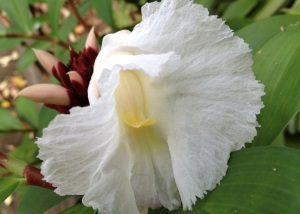
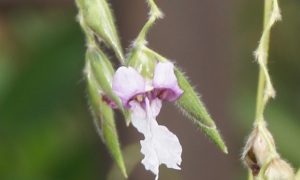
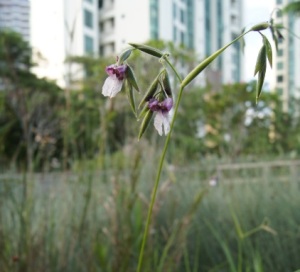
![IMG_3512[1]](https://purebiologyrs.files.wordpress.com/2014/11/img_35121.jpg?w=300&h=225)
